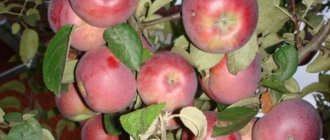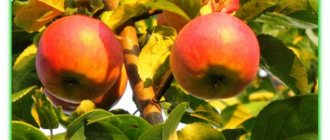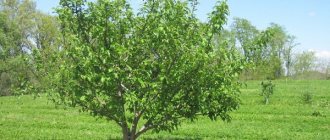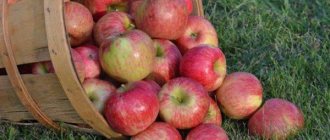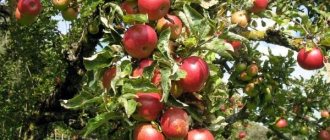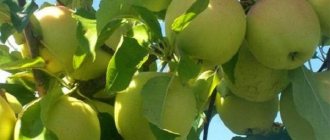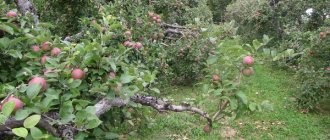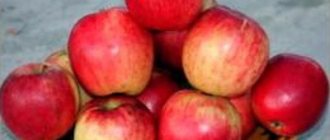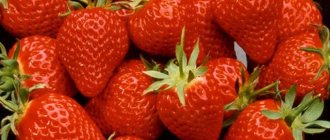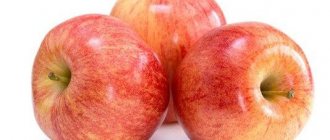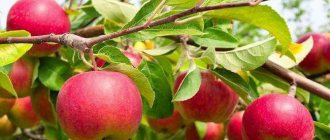» Gardening » Apple tree » Description, rules for planting and caring for an apple tree sweet bliss
0
520
Article rating
The sweet bliss apple tree variety was bred by breeder L.A. Kotov at the Sverdlovsk experimental station. The harvest of this crop is intended exclusively for fresh consumption. Let's look at the main characteristics of a tree, as well as how to properly plant and care for it.
- Care
- Watering
- Feeding
- Trimming
- Preparing for winter
- Diseases and pests
- Harvest storage rules
- Reviews from gardeners
Description, rules for planting and caring for the sweet bliss apple tree
Description
The Sweet bliss cultivar is one of the many wonderful varieties of apple trees of Sverdlovsk selection, bred by Professor L. A. Kotov. This is a large-fruited summer-ripening variety, selected for cultivation in harsh winter conditions.
For some reason, the variety is not yet widespread, but professionals are well acquainted with it. Therefore, the variety is often called “collection”, i.e. designed for connoisseurs.
According to experts, the taste of the Sweet Bliss fruits is superior to many varieties grown in the almost ideal climatic conditions of the southern regions of the country.
Description of fruits
Apples of this variety do not differ in size - the fruits are of medium size, the average weight is about 100-140 grams, often less - about 80 grams. These are all variants of the norm and it is impossible to increase the size of the fruit by any means. The shape of the fruits is round, slightly flattened at the top and bottom, and occasionally the fruits are elongated. The color of apples is varied, they are not monochrome - usually greenish-yellow apples are abundantly covered with a rather bright blush, on all sides.
Inside there is very light, almost white pulp. Its structure is fine-grained, very sweet, with a bright honey flavor. No acid is felt even in the aftertaste. The fruits are crispy and juicy.
The tasting ratings of the variety are very high - above four. At the same time, apples have a very bright, rich aroma, very pleasant and intense.
Characteristics
Characteristics of the Sweet bliss variety: the apple tree is a medium-sized tree with powerful skeletal branches.
- The crown is heavily leafy, dense, oval.
- The first harvest is obtained 4–5 years after planting.
- The fruits are large, weighing up to 200 g.
Peculiarities
Experts attribute the quality of the fruit to the main features of Negi: the memorable taste of apples will not leave any sweet lover indifferent. An important property of the variety is its good tolerance to very low temperatures. Thanks to this feature, gardeners who grow fruit trees in regions with harsh winters have the opportunity to grow a full-fledged large-fruited apple tree.
Tree
The apple tree is medium-sized, the height does not exceed 3.5 meters, which is very convenient when carrying out agricultural activities and harvesting. Crown with dense foliage of pale green color.
Fruit
Apples are round, flattened or oblong. Both forms of fruit are found on the same tree. The skin is bright yellow with a beautiful crimson blush. In the photo, the Sweet Negi apples look very appetizing. The taste is dessert, honey without a hint of sourness. The pulp is creamy-white, tender, juicy, crisp, highly aromatic. The tasting score on a five-point scale is 4.3.
Fruits of the Sweet Nega apple tree.
Productivity and timing of fruiting
The apple tree begins to bear fruit at 4–5 years. The first abundant economically useful harvest is obtained in 6–7 years. Provided that during the first flowering all inflorescences are removed, it is possible to obtain a bountiful harvest the following year.
By observing all the necessary agrotechnical measures, it is possible to ensure that the apple tree bears fruit regularly without pronounced frequency.
Winter hardiness and scab resistance
The apple tree variety Sweet Nega is very frost-resistant and winter-hardy. The tree can withstand winter frosts down to –42 degrees. Resistance to scab and other fungal infections is average.
Reviews from gardeners
This variety is intended for lovers of sweet apples. Its cultivation is not widespread. But gardeners who have this type of crop on their plots speak positively about it.
Excellent frost-resistant characteristics and ease of care make this variety of fruit trees attractive to gardeners.
Gardeners who breed varietal trees note that the more effort you put into caring for them, the richer the harvest of the Sweet bliss variety will be.
Landing
Seedlings of varieties grown in regions with harsh winters are best planted in a permanent place in the spring. Over the summer, the young growth has time to take root well and prepare for wintering.
The fruits of Sweet Bliss need a lot of sunlight, so the seedling needs to choose a sunny place. Nega is undemanding when it comes to soil quality, but on fertile, breathable soils the apple tree will feel much better.
Planting the Sweet Nega apple tree in spring.
The groundwater level should be no higher than 2 meters. The root system of Sweet bliss develops deeper, so if groundwater is close, the roots will begin to rot.
Planting pattern when planting several seedlings: 2.5-3 m between trees x 4 m between rows.
Growing
Agricultural technology for growing Sweet bliss comes down to the main activities:
- regular watering;
- timely complex fertilizing;
- sanitary pruning and crown formation;
- prevention of infections, treatment against parasites.
The variety is not drought-resistant, therefore it requires timely moderate watering: three moisture-recharging and about five vegetative ones. Does not tolerate stagnant moisture.
Fertilizers are applied according to the scheme, following the recommendations of the instructions on the packaging. Organic fertilizers are applied in the fall, mineral fertilizers - in the spring.
It is imperative to loosen the soil and clear the tree trunk circle of organic debris.
Pruning and crown formation
Pruning is carried out in early spring , removing old, outdated branches (keep in mind that fruits are formed on shoots of four and five years of age), younger shoots and branches growing inside the crown are shortened.
In the fall, you can carry out sanitary pruning - remove damaged and weak shoots, which can become a source of fungal or bacterial diseases of the tree. But this is done in extreme cases - in general, it is recommended to prune the tree only in the spring.
Types of apple tree pruning.
Watch the video on how pruning is done in spring:
And a video about autumn pruning:
Features of ripening and fruiting
To obtain a subsequent abundant harvest, it is recommended to completely remove the flowers at the first flowering. In the future, it is recommended to normalize the number of fruit ovaries in order to significantly improve the quality of the fruit.
Apple harvest Sweet Bliss.
The variety is self-fertile and can easily do without pollinating companions.
Deadlines
The Sweet bliss variety is so unique that it contradicts some laws inherent in other apple crops: late flowering is combined with early fruit ripening.
Flowering, ripening and fruiting
The apple tree begins to bloom in June. Given the harsh growing conditions, flower ovaries will not die from return frosts, which sometimes return even at the end of May.
According to the period of fruit ripening, the variety belongs to the summer assortment. The fruits ripen in late August - early September. Fruit ripening is almost simultaneous.
Storage and collection of fruits
The fruits of Sweet bliss can be stored for no more than a month, so it is best to eat them straight from the tree. Due to its dessert honey taste, it is most suitable for fresh consumption. Due to their thin skin, apples practically cannot withstand transportation.
Apples are removed from the tree along with the stalks and placed in wooden boxes. Store fruits for no more than three to four weeks in a dark, cool, well-ventilated area or simply in the refrigerator. After 4 weeks, the apples deteriorate and lose their aroma and taste.
Description of the variety, features
Before purchasing an apple tree, gardeners recommend studying information about the variety. This will help avoid many troubles when growing. First of all, choose the right place for planting, then take into account the small details of care.
Sweet Nega is best grown in an open area; the more sunlight the tree receives, the sweeter its fruits. The apple tree variety is a summer apple variety. They are grown exclusively for fresh consumption or processing:
- tree height 3.5 m;
- the branches are massive, dense;
- the crown is strong and powerful;
- begins to bear fruit in the 4th year;
- apple weight up to 200 g;
- The shade of the fruit is yellow, partially covered with a red blush;
- the shape of the apple is varied, round, slightly flattened or elongated;
- taste sweet;
- the aroma is persistent;
- are stored for 1 month.
According to tasters, the taste of apples is rated 4.3 on a 5-point scale. Based on a detailed description of the properties of plants and fruits, it is easier for a summer resident to decide on the choice of variety for cultivation.
Apple tree varieties
In addition to its own root form, the Sweet bliss apple tree is grown on semi-dwarf or dwarf rootstocks. The dwarf rootstock in this case manifests itself as super-dwarf.
- On semi-dwarf clonal rootstock Ural 5: an adult tree up to 3 m high, begins to bear fruit in 2-3 years. It has a powerful root system and is drought-resistant. Promising for cultivation in northern regions.
- On a dwarf rootstock, Baby Budagovsky: the height of an adult tree is 1.5-2 m, needs constant support. High drought resistance and resistance to pests and diseases. Fruiting begins in the 3rd year.
Apple tree Sweet Nega on a semi-dwarf rootstock.
Apple tree Sweet bliss
Columnar
There is no variety of the columnar apple tree Sweet bliss.
In general, columnar apple trees require constant care. Starting from planting, in which the root system needs to be formed, to regular pruning. This type of apple tree is very helpful for gardeners when there is not enough free space on the site .
Reviews
Evgeniya, Stavropol: “An excellent summer variety. The apples are eaten almost immediately; I only have time to bake the charlotte a couple of times. By the way, the aroma when baking is indescribable! Easy to care for, just needs watering. The lawn grass in the tree trunk retains moisture and weeds do not grow.”
Stanislav, Bryansk: “Very tasty apples! Honey, they melt in your mouth. The grandchildren simply adore them. And when we cook the compote, the aroma fills the whole house! Our Nega has been growing for about eight years. One tree is enough, we’ll gorge ourselves on apples.”
